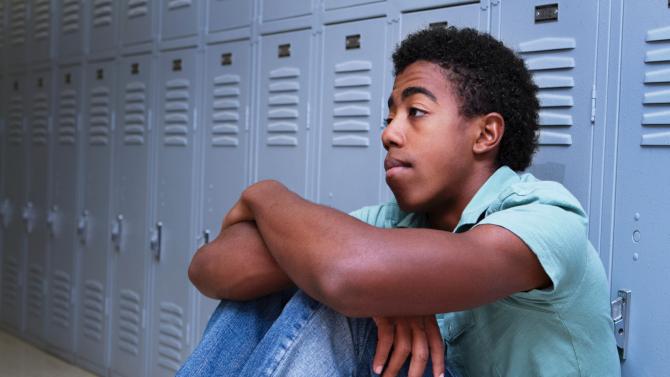[ad_1]

On Wednesday night, we saw a video of yet another student being physically brutalized and criminalized by an armed school police officer, this time in San Antonio. The 12-year-old girl, Janissa Valdez, was body-slammed, face-first, on the concrete before being handcuffed and taken away. The scene was reminiscent of another horrific incident involving an officer ripping a young black girl out of her desk at Spring Valley High School in Columbia, S.C., and throwing her across the classroom last October.
But these incidents are not isolated. In fact, they are part of a sad reality that youths in urban communities have lived with for decades. We have to call it what it is: Many of our schools feel more like prisons than places of learning.
And the studies back it up. New data released by The 74 found that three of the country’s largest school districts—Chicago, New York City and Miami—invest more money in policing students than in helping them. That means there’s plenty of funding for the harsh disciplinary policies that disproportionately criminalize and push young black students out of school and into the school-to-prison pipeline, but little for the types of measures that could help keep students in school, where they belong.
For roughly two decades, youth and parent organizers from across the country have advocated for solutions that dismantle the school-to-prison pipeline and create school climates that make students feel safe and supported. We know from our work that in schools serving predominantly low-income black students, the heightened presence of armed police and security staff contributes to a climate of distrust that makes students feel less, not more, secure.
“School police walk around with dogs and are armed with the same equipment used by standard police forces. As a student, this makes me feel like school staff expect something bad to happen and that my peers and I can’t be trusted,” says Keisha Campbell, a student at Miami Norland Senior High School.
Data show that in Miami-Dade County, black students are four times more likely to get arrested than white students. Last year, every single student arrested for “disorderly conduct” in our school district was black. Creating a jail-like environment within our schools only leads to more students ending up in jail, leading us to think that maybe we should call it the “prison-like school to actual-prison” pipeline.
According to data from the Florida Department of Juvenile Justice, last year in Miami-Dade, 477 students (mostly black) were arrested for minor issues that could have been better handled by counseling or restorative interventions. Research shows that in addition to feeding a racially biased criminal-justice system, placing armed police in schools actually increases physical dangers to youths.
“It’s pretty simple,” says Annie Thomas, a youth organizer with the Power U Center for Social Change in Miami. “We need to stop arresting and suspending students for minor misbehavior.”
She’s right. We all want safe schools. But we won’t get them with guns, handcuffs, or increased use of detentions and suspensions. We make our schools safer by investing in community building. This means strengthening relationships with the entire school ecosystem, including students, parents, teachers, administrators and neighbors.
Restorative justice is an alternative to harsh discipline that actually does this type of community building. It shifts culture and develops the kind of trust and relationships that prevents student misbehavior in the first place. In a report about the successful implementation of restorative justice in Denver Public Schools, it was found that after a year of using restorative justice, one school “saw … a huge drastic decline in suspensions. … We also did a really good job of tracking repeat offenders and saw huge decline in that.”
Overreliance on policing in schools has an effect that is the opposite of community building. At best, the tools available to police and security allow them to react to disruptions in schools rather than prevent them. “If something happens in the classroom, a security guard gets called and then they call the police,” Campbell describes. In this scenario, seldom is anything done to address what caused the problem in the first place. What was going on with the students involved in the conflict? What challenges might they be facing at home? Are there unaddressed mental-health issues making it harder for a student to feel integrated in the school?
Students living in low-income communities face housing insecurity and homelessness, lack of high-quality nutrition, inadequate health care and a host of other challenges. Addressing these underlying root problems is a responsibility that we all share if we truly want our young people to be safe. These are the types of issues that counselors are trained to address. Police and security staff are not.
As black students and parents, we live in a society that generally expects us to fail. We are stereotyped, criminalized and forced to deal with recurring traumas. However, we are also extremely resilient and resourceful, and we know what our communities need. School districts must make investments that tap into this wealth of human resources. We must uplift the leadership of parents and honor the right of students to be part of decisions that affect their lives. We go to these schools and we send our children to these schools. Let’s hire and pay professionals who are trained to help unleash student potential rather than lock it behind bars.
The Root aims to foster and advance conversations about issues relevant to the black Diaspora by presenting a variety of opinions from all perspectives, whether or not those opinions are shared by our editorial staff.
Shi’kera Carr is a senior at Miami Northwestern Senior High School. Ruth Jeannoel is the lead organizer at Power U Center for Social Change in Miami and also a member of Echoing Ida, a program of Forward Together.
[ad_2]





















